Quick Navigation
There are many ways to lock a door without a lock. In this guide, we teach you 10 easy ways to do so in case you don’t have a regular lock.
Locks are the most convenient and reliable way to secure your door. But if your door lock breaks or your door doesn’t have a lock for whatever reason, there are some other ways you can lock your door.
The simplest way to lock a door without a lock is by jamming it with a chair fit right below the handle. For extra security, you can also insert wedges beneath the door. Another DIY method is to remove the door handle from the outside.
1. Block With a Chair
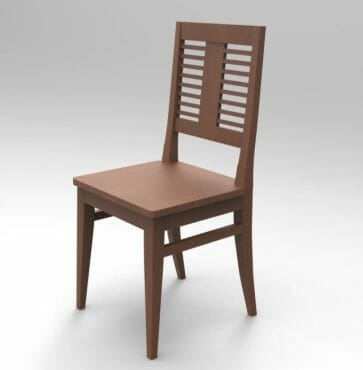
A sturdy chair can be effectively be used to block the door, especially if the chair has a straight back. You can angle the chair and fit the top of the chair just under your door handle. An angle of about 25 degrees vertically can create enough friction to keep the door from opening.
Ideally, the angle should not be much larger or smaller than 25 degrees as it would compromise the hold of the chair against the ground. So, choose a chair that is taller than the height of your door handle but not too much taller.
Another thing you can do to increase friction is to use a chair that has rubber feet. Rubber feet can significantly increase the friction between the floor and the chair, and friction is the only force you’re counting on here.
The back of the chair can also be placed so that it keeps a lever-style door handle from turning, making it appear that the door is locked.
Using a chair this way is a quick, easy, and convenient way to block your door. But this is not the most secure way and can only be used as a temporary fix. With enough force, the friction between the floor and the chair legs can be overwhelmed, especially if the chair is too long or too short or if the chair legs don’t have rubber tips.
2. Use a Belt

Leather has a tensile strength of 25 MPa, which is higher than most other materials ropes are made out of. Although this is not as high as steel, leather isn’t affected by a jerk or a shock as badly. This makes a belt a pretty secure temporary alternative to a deadbolt.
You can wrap a leather belt to the door handle and some latch or a heavy object near the door. If you have a lever-style door handle and the deadbolt is still intact, you can just use the belt to limit the motion of the handle.
You can also use a rope instead. The thickness of the rope doesn’t matter much if you’re using the rope just to limit the motion of the lever-style court handle.
But this method may not be available to you if you don’t have anything near the door to secure the door with. Let’s see what other options you have.
3. Portable Door Lock
A portable door lock is a really convenient way to secure your door. A portable door lock consists of a metal claw that fixes itself into the existing bolt or latch. The claw is attached to a simple plate that you just have to turn to lock the door.
Portable locks don’t cost much and are ideal for travelers who can’t install a deadbolt in the room they’re staying.
However, like all the other DIY locks, this lock can’t be used to lock a door from outside.
4. Security Bar
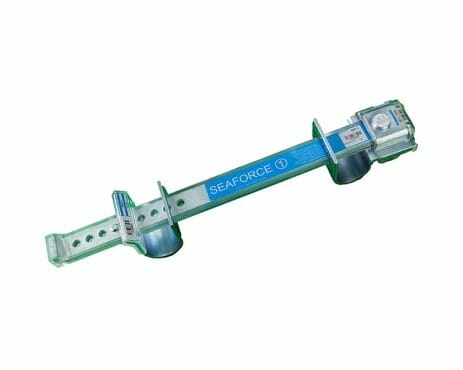
If you’re looking for serious security against intruders, security bars are the real deal. Security bars consist of two brackets and a metal or wood bar. The brackets need to be screwed to the wall or the doorframe while the bar sits on top of the brackets.
Security bars don’t take much time to install, and you can keep them installed for extra security even after you’ve installed a lock.
But a security bar is not an option for a door that opens outwards. This option may also be too intrusive if you’re only looking for a temporary solution.
Here’s a DIY door security bar guide for you to check and make later on.
5. Door Jammer
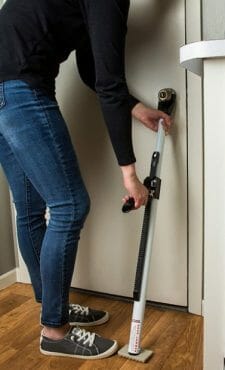
A door jammer is a bar designed as a DIY security measure against intruders. It is usually used to make your door extra secure when you already have a lock, but it can also be used as a temporary alternative to a door lock.
A door works using the same principle as the chair method described above, but a door jammer offers much more friction than a chair. Door jammers allow you to adjust their height, which can allow you to angle the door jammer perfectly at 25 degrees.
Door jammers also fit, onto the door handle really tightly and can’t be removed by shaking the door. Door jammers have a padded foot at the bottom end, which provides friction and keeps the door from being forcefully opened inwards.
6. Floor Barricade
This option is somewhat similar to using a security bar, as this is also more of a permanent additional security measure than a temporary alternative to a deadbolt. But you can use it as an alternative and continue to use it when you install a lock.
A floor barricade consists of two components; a base that is attached to the floor and a barricade that keeps the door from opening inwards. The base needs to be screwed to the floor, whereas the barricade latches onto the base.
A floor barricade is a more visually appealing option than a security bar. But if you’re considering this option, there has to be enough space between the floor and the bottom of the door for the door to freely open over the base.
7. Strike Plate Lock
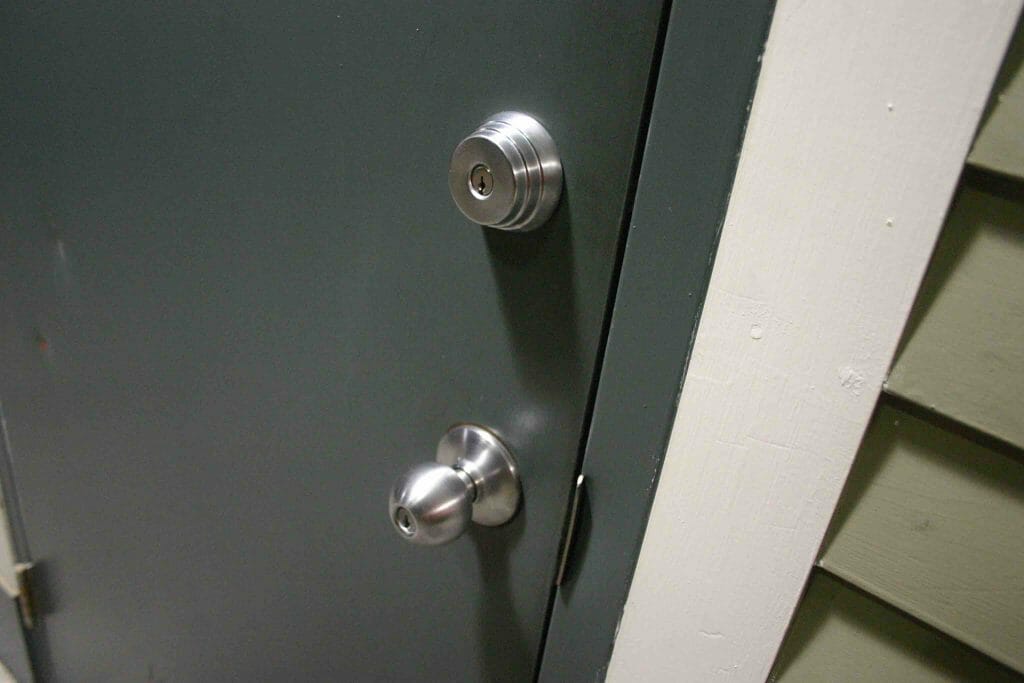
A strike plate lock is a device similar to a stand door chain. A strike plate lock consists of a plate that is mounted to the door frame and a chain with a ring that can be latched to the existing door handle.
The chain used in a strike plate lock is much thicker and stronger than a door chain. A strike plate is also more secure than a door chain since its plate is more firmly attached to the inner side of the door frame. Another advantage this option has over others is that you can continue to use the strike plate lock as a door chain once you have a door lock.
8. Lock a Door With a Fork
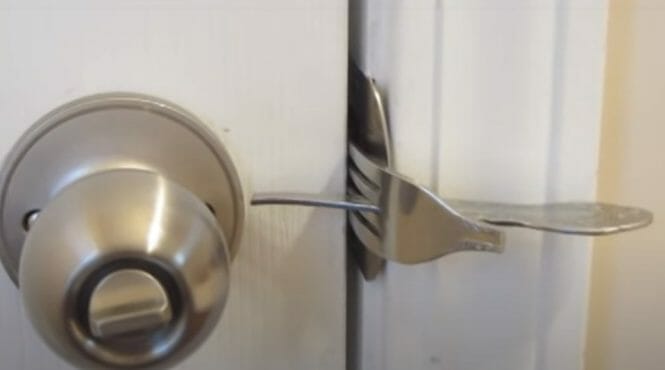
This is one of the simplest ways to temporarily secure your door. The method is actually inspired by the way the previously mentioned portable door locks work. Here’s how to use a fork to make a temporary lock.
- Grab a fork and bend its tines at a right hand such that the tines fit into the latch of the doorframe while the body can fit in the gap between the door and the door frame.
- Break the handle of the fork from the neck.
- Insert the handle through the tines of the fork, restricting the door from moving horizontally.
Instead of breaking the fork, you can also use a different utensil to block the door as long as it’s thin enough to pass through the tines when the fork is in place.
9. Use a Doorstep
A doorstep is perhaps the simplest way here to secure your door. Doorstep is a triangular piece of wood that sticks between the bottom of the door and the floor and limits the motion of the door in one direction.
Doorsteps are usually used to keep doors from closing but, provided enough friction, they can also keep a door from opening. (1)
You can make the door more tightly secure by simply pushing the doorstep beneath the door more tightly. You can also nail a sheet of leather beneath the doorstep to increase its grip on the floor.
Using multiple doorsteps can also work, but the number doesn’t matter since the source of the force of friction is the force by which the door is pushing down on the doorstep. But multiple doorsteps can help distribute the force evenly and keep the bottom of your door from being damaged.
10. Remove the Outside Handle

If your lock is compromised, but the deadbolt is still good, you can temporarily remove the handle outside to keep anyone from unlocking the door. However, this won’t be enough to stop a serious intrusion; and as it’ll still be possible to access the lock mechanism from outside using simple tools. This method is best used in combination with other methods as an extra layer of security, but you can’t rely entirely on this. (2)
Some of the ways discussed here provide more reliable security than others. In particular, the methods that don’t require any you to have to buy anything have certain flaws that make them less secure. But, nothing is stopping you from using multiple methods at the same time. You can use a fork, insert a doorstep, remove the door handle, and block the door with a chair and it will be as secure—nay—more secure than using a strike plate lock. But these methods are still limited by the fact that you can’t use any of these as a permanent solution.
Here are other learning guides of how-to’s that might, later on, help you.
References
(1) friction – https://www.britannica.com/science/friction
(2) mechanism – https://www.britannica.com/technology/mechanism-machinery

